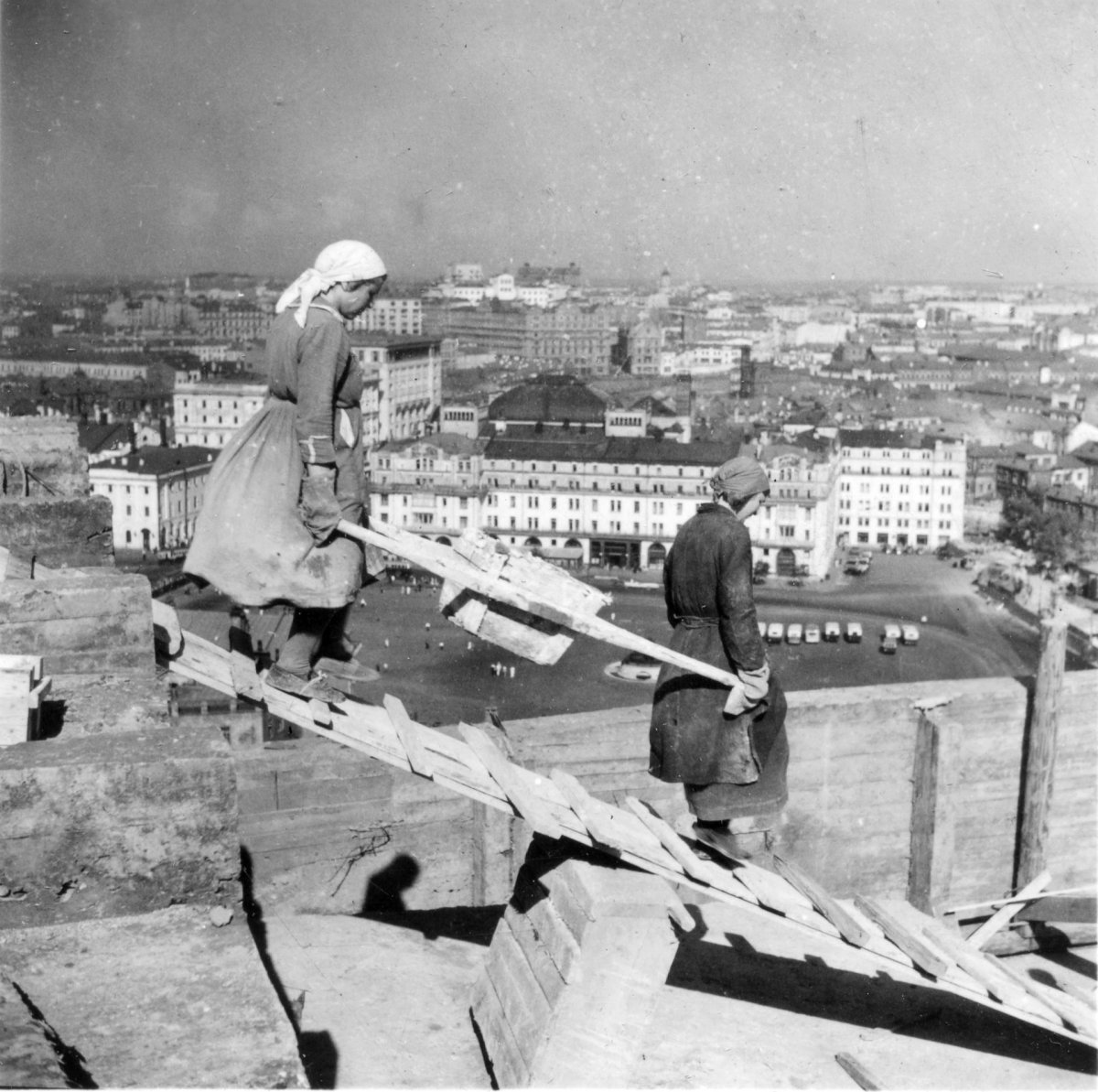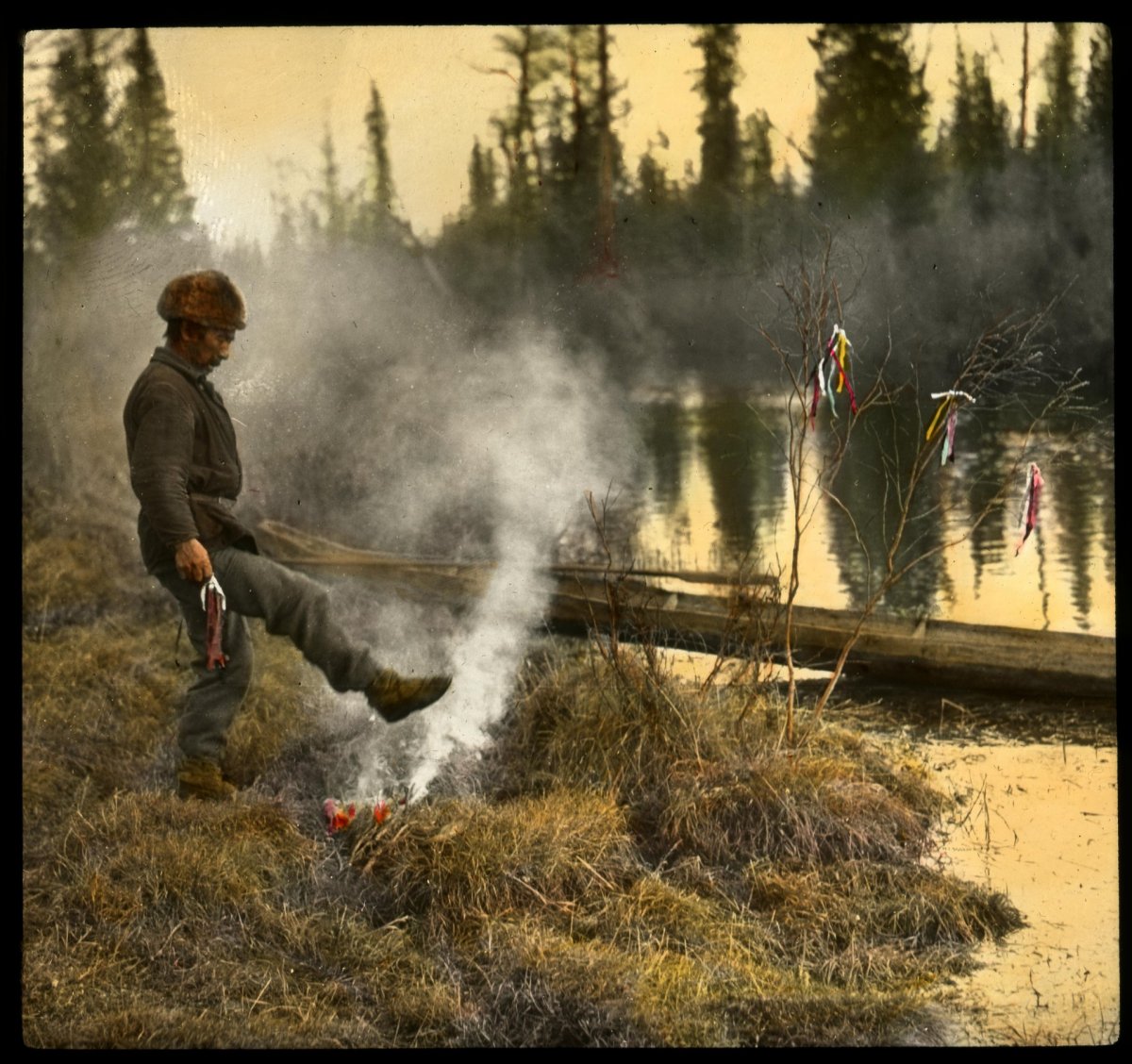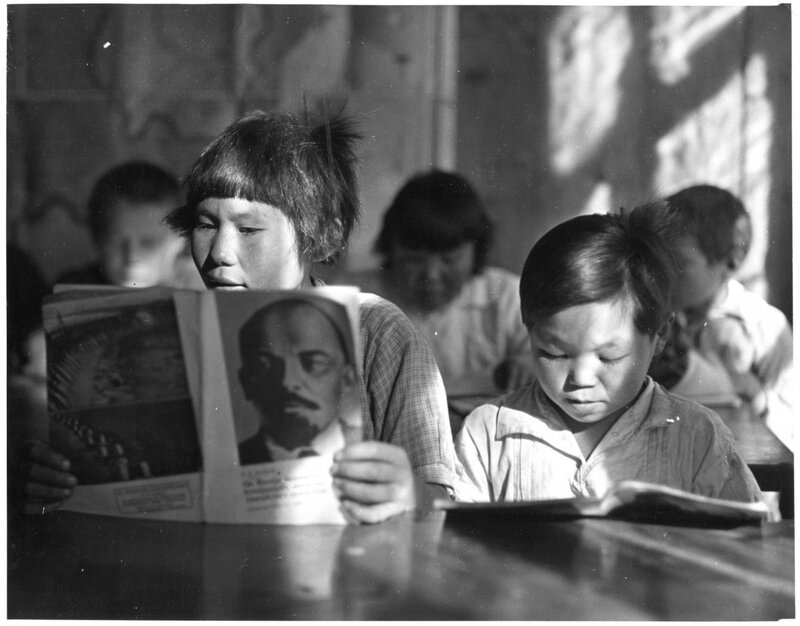Rafał Leśkiewicz: Julien H. Bryan is known in Poland primarily as the author of pictures documenting the siege of Warsaw in 1939. His photographs from that September constitute an extremely suggestive and exact image of the heroism of Warsaw residents on the one hand, and a testimony of the cruelty of Germans in the first days of the war on the other. Your album is a record of both the earlier and post-war exploits of this well-known reporter. How did Bryan end up visiting the USSR several times?
Tomasz Stempowski: It was because of his curiosity about the world and people. In 1930, Bryan was a young man who wanted to travel, take photographs and make films. He chose the Soviet Union because, as he put it in the words used in the title of the album, it was the most mysterious of countries, not just in his opinion, but also for a large part of the American society. Even before the revolution, the Americans were fascinated with Russia: the sheer size of the country attracted their attention, and what is more – as surprising as it may seem – they noticed certain similarities. Bryan wrote, "Both countries are vast and rich, with countless untapped resources. Both nations are pioneers and love adventure, expansion, and pursuing new goals. Both are still close to the times of the Wild West and wooden huts".
After the revolution, Americans' curiosity grew even more. However, as the United States did not maintain official diplomatic relations with the Soviet Union until 1933, the flow of information and, of course, travel, were difficult. At the same time, reports from that country were often contradictory: the press wrote both about persecution and poverty, and about the development of industry and culture; the Soviet propaganda also added to the confusion. It must be remembered that the Great Depression after the 1929 market crash affected millions of Americans. Every day, they saw long breadlines, contrasted by the Soviets with the image of smiling workers in new factories. It is hard to believe, but during the first eight months of 1931, the Amtorg agency in New York, facilitating economic contacts between the two countries, received more than one hundred thousand visa applications from Americans wishing to emigrate to the Soviet Union. It was difficult to work out what the real situation in this country was; apparently, you had to go there to find out. So when in 1930 Bryan came across an advertisement in a newspaper about a trip organized by Maurice Hindus, a specialist on Russia, he jumped at the opportunity. What he saw fascinated him enough to make him return for the next seven years. He became an expert himself, and worked as a guide for similar expeditions. He also gave lectures on the Soviet Union, illustrated with photographs and footage he had brought from there. They attracted thousands of viewers.
RL: There are many photographs from Bryan's visits to the Soviet Union. What were your criteria for selecting the material for the publication?
TS: Before making the choice, I had taken a long time to get to know the collection. Unfortunately, many of the photographs had been poorly described or lacked a caption whatsoever. Identifying what was in them proved very laborious and sometimes impossible. Bryan photographed the Soviet Union for three decades and roamed vast areas, from Moscow and Leningrad, through Belarus, Ukraine, Kazakhstan, Turkmenistan to the Caucasus and distant regions of Siberia. He took thousands of pictures during that time. I was faced with a dilemma whether to choose a narrower period or a topic, or to show a cross-section of the entire collection of Bryan's work from the USSR. The first variant offered a chance to prepare a more coherent publication but left out many great photographs. The second one posed a threat of chaos, but allowed a wider presentation of the American photographer's legacy. I chose the latter option because, in my opinion, Julien Bryan – despite having two albums of photographs from September 1939 already published by the Institute of National Remembrance – remains an unknown and underappreciated photographer. I wanted the viewer to see the wealth of his work. I decided to put the photographs in three separate chapters devoted to the subsequent decades, from the 1930s to the 1950s. In each of the periods, the situation in the Soviet Union was different, the reasons for Bryan's visits and their nature changed, and so did the photographs.

When selecting the images, on the one hand I tried to show the Soviet Union as comprehensively as possible to the extent that the preserved photographs allowed, and on the other, I wanted to outline Bryan’s artistic profile. Therefore, in a sense, I let him decide for himself. There are topics that he paid attention to in every country he visited, e.g. the situation of children, religion, the position of women, theatre, schools, agriculture, etc. I decided that his interests had to be respected and reflected. I also wanted to show the photographic traditions that shaped him: Bryan was primarily a filmmaker, which made him think of photography as a sequence of images, and it shows in the pictures from the 1940s. They form a kind of a photo report of UNRRA's work in Belarus and Ukraine. He was also influenced by the tradition of travelogue, that is, lectures on various countries, illustrated with films or slides, often colored. That is why in the album I have included copies of hand-colored slides used for such shows. They are often reproduced scenes from black-and-white photographs. Naturally, I tried to choose visually attractive shots and those that might be of interest to the reader in terms of topic – such as the photographs from a puppet propaganda show in which Poles were shown as enemies.
RL: How did the photographs from Bryan's visits to the Soviet Union become part of the resources of the Institute of National Remembrance?
TS: We became interested in Julien Bryan more than ten years ago. In connection with the round anniversary of the outbreak of World War II, we reviewed the photographs documenting the German invasion of Poland in 1939. It quickly turned out that most of them were taken by Wehrmacht soldiers and presented their perspective. An exception were the great photographs of Julien Bryan from the siege of Warsaw. On the internet we found the website of the International Film Foundation, managed by Julien's son, Sam. We made contact and it quickly turned out that, just like his father, he is very friendly towards Poland and open to cooperation. Soon, the Institute of National Remembrance signed an agreement with him, as a result of which digital copies of Bryan's photographs from Poland and Germany, the originals of which are kept in the Holocaust Museum in Washington, entered the Institute’s archival resources. Then Sam Bryan told us that in his private archive he also had a collection of photographs his father had taken in the Soviet Union. As the history of Poland is closely related to what happened behind our eastern border, we were interested in its contents. Sam Bryan agreed to sign an appendix to his earlier contract, and, consequently, we got an opportunity to scan this part of his father's legacy and include digital copies of photographs and documents in the IPN's resources. I must stress Sam Bryan’s generosity here: he allowed us to copy the materials and to use them for the Institute’s statutory activities absolutely free of charge.
RL: In addition to the photographs, the album includes three articles by Julien Bryan. One of them, entitled "Adventures Among Siberian Reindeer Herders" dated 1935, is a typically journalist piece. The other two, "How I Get Pictures" and "If I Were to Do it Again", are more personal. What does Bryan write about in these texts?
TS: The "Adventures among Siberian Reindeer Herders" is an account of a trip to the areas inhabited by the Tungusic people (now known as the Evenks). Bryan made it in 1934, accompanied by Russian ethnographer Bernhard Petri, who died a few years later in the Stalinist purges. The American photographer presents the traditional way of life of the Tungusic people, and explains how it changed as a result of the actions of the Soviet administration. He writes through his experiences, describing, among others, the friendship with twelve-year-old Nutka, a squirrel hunter, who is amazed that he, an adult man, cannot hunt. The text also shows how well Bryan is able to change his point of view and look at himself with the eyes of his interlocutor.

"How I Get Pictures" is a collection of excerpts from Bryan's unfinished book. He wanted to present his professional experiences related to travel, photography and filming in various regions of the world. Some of the fragments refer to Soviet Russia.
The last text, "If I Were to Do it Again", is more of a guide on how to prepare yourself for taking photographs in a strange country.
RL: What new things can we learn about the Soviet Union by looking at the photographs taken by Julien Bryan?
TS: Bryan's photographs and texts can certainly draw our attention to the aspects of history that we sometimes forget. We tend to see the Soviet Union in purely political terms, as a whole. Meanwhile, Bryan photographed not so much the Soviet Union but the people living there. As a result, he managed to convey the country’s diversity. Because what did the life of a Soviet ministry official have in common with the experiences of a Tungusic raiser of reindeer? Bryan captured both. The very geographical remoteness of the places where he took pictures shows how diverse the country was, or rather, that it was actually many countries under one name. We can also find Bryan’s images of how the Soviets tried to gather and control the countries and people. They show, above all, the ever-present propaganda, trying to impose the strange communist ideology on all citizens. This is clearly visible in the photographs of Tungusic schoolchildren, studying from a textbook in the Irkutsk Oblast: on the cover of the book is Lenin.
RL: Analyzing Bryan's journalistic yield from his travels to the USSR, is it possible to say that the Soviet country fascinated him?
TS: It certainly did. As I said, it was the trip to the Soviet Union that marked the beginning of his career as a traveler and filmmaker, and later Bryan returned there many times. He took thousands of photographs, made several documentaries and wrote some texts about the country. At the same time, however, we should look at this fascination in the context of Bryan's entire professional career. He took pictures and filmed on five continents. For example, he dedicated more than twenty films to the countries of South America. After all, he was in Poland at least six times, and it was Poland that he visited just before his death. He was sick by then, and his son Sam accompanied him on his journey. The Soviet Union was therefore only one of his passions and probably not the greatest.
RL: Which of the photographs published in the album do you find the most interesting?
TS: This is by far the most difficult question. Bryan took so many good photographs of different genres that choosing one is almost impossible. His journalism and documentary shots reflecting the paradoxes of everyday Soviet life and the ever-present propaganda are outstanding. Take, for example, a photograph of men shaving themselves in a barbershop in Moscow in 1935, or the images, dated the same year, showing women working high up at a construction site of the "Moscow" Hotel without safety equipment, or 1946 pictures of children in kindergarten, playing under the watchful gaze of Stalin, looking at them from a portrait on the wall. The ethnographic photographs documenting the customs of the peoples of the Caucasus and Siberia, including unique images of the Evenks’ shamanic rituals, are incredibly valuable. There are also shots that briefly characterize broader social, political or economic phenomena, such as the photograph of American milk cans from UNRRA supplies on a store shelf, right next to the portrait of Stalin.
Portraits, however, fascinate me the most. It is in them that you can best see Bryan's attitude towards the other person and the willingness to talk to them. As he once said: he accepted people as they are, not as he would like them to be. This is clearly evident in his photographs. The faces of the portrayed people show their confidence in the photographer, there is no tension or artificiality in them. Those who stand in front of the camera lens do pose, but they are nevertheless relaxed. Bryan shows them in their natural surroundings; characteristically, he does not often use the vertical orientation typical for a portrait, but chooses the horizontal one, which forces greater presence of the background in the frame. And other people, the street, a piece of wall or simply the sky, are the background for his models. Bryan does not try to isolate and pin them, like these children in the photo taken in Kharkiv in 1934 pinned insects to the boards they’re holding. If I were to choose only one of the portraits by Bryan, I would have opted for the color photo of the boy at the end of the album. It has everything I mentioned.
RL: Thank you very much.
